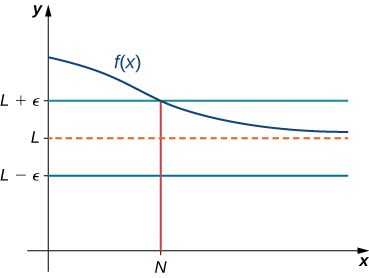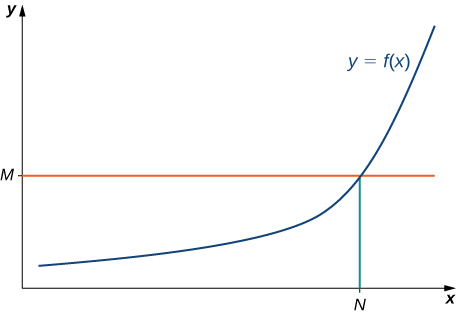| << Chapter < Page | Chapter >> Page > |
(Informal) We say a function has an infinite limit at infinity and write
if becomes arbitrarily large for sufficiently large. We say a function has a negative infinite limit at infinity and write
if and becomes arbitrarily large for sufficiently large. Similarly, we can define infinite limits as
Earlier, we used the terms arbitrarily close , arbitrarily large , and sufficiently large to define limits at infinity informally. Although these terms provide accurate descriptions of limits at infinity, they are not precise mathematically. Here are more formal definitions of limits at infinity. We then look at how to use these definitions to prove results involving limits at infinity.
(Formal) We say a function has a limit at infinity , if there exists a real number such that for all there exists such that
for all In that case, we write
(see [link] ).
We say a function has a limit at negative infinity if there exists a real number such that for all there exists such that
for all In that case, we write

Earlier in this section, we used graphical evidence in [link] and numerical evidence in [link] to conclude that Here we use the formal definition of limit at infinity to prove this result rigorously.
Use the formal definition of limit at infinity to prove that
Let Let Therefore, for all we have
Use the formal definition of limit at infinity to prove that
Let Let Therefore, for all we have
Therefore,
We now turn our attention to a more precise definition for an infinite limit at infinity.
(Formal) We say a function has an infinite limit at infinity and write
if for all there exists an such that
for all (see [link] ).
We say a function has a negative infinite limit at infinity and write
if for all there exists an such that
for all
Similarly we can define limits as

Earlier, we used graphical evidence ( [link] ) and numerical evidence ( [link] ) to conclude that Here we use the formal definition of infinite limit at infinity to prove that result.
Use the formal definition of infinite limit at infinity to prove that
Let Let Then, for all we have
Therefore,
Use the formal definition of infinite limit at infinity to prove that
Let Let Then, for all we have
The behavior of a function as is called the function’s end behavior . At each of the function’s ends, the function could exhibit one of the following types of behavior:

Notification Switch
Would you like to follow the 'Calculus volume 1' conversation and receive update notifications?